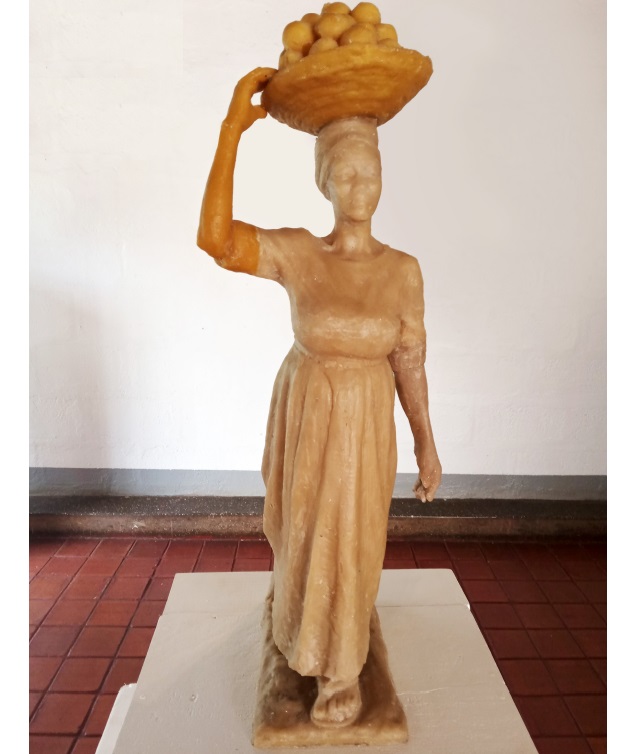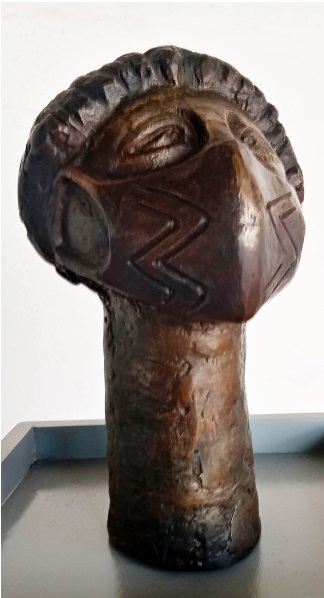
The exhibition demystifies the diverse misconceptions on the art of bronze casting.
| DOMINIC MUWANGUZI | Bronze may be an unfamiliar media on the local art scene, evident with hardly any sculptural artwork made out of the material, save for the Flying Crested Crane 2007 standing at British High Commission Offices in Kampala. Yet pre- historical archives reveal the art of Bronze sculpture making is one of the oldest art form on the Africa continent dating back many centuries ago. The famous Benin Bronze sculptures which represent the rich cultural heritage of the ancient Benin Kingdom, in West Africa, give validity to this claim.
In a way to demystify the misconception about bronze as a non- indigenous metal and also the complexity and dexterity involved in the production of bronze figurines, an exhibition of sculptural works opened recently at Makerere Art gallery. It is more about the technique and process of art making the exhibition emphasizes, rather than the concept and message underlying the artworks. Therefore, the sculptures exude a diversity of character: from the finished, work in progress or sometimes the unfinished figurines to the imperfect, which unanimously reflect the different approach to bronze casting by the different artists with different backgrounds.
 The process of bronze casting, depending on either a skilled or unskilled welder, will often conspire to what comes out finally. As such, an experienced bronze sculptor like Erik Blome can effortlessly sculpt any object from any media- bronze, brass and bee- wax, rather than Dr. Lilian Nabulime or Fedelis Nabukenya who are engaging with the material for the first time. Nabulime’s sculptural background is working with hardwood and fired clay (terracotta) which materials altogether provide a different experience in technical dexterity.
The process of bronze casting, depending on either a skilled or unskilled welder, will often conspire to what comes out finally. As such, an experienced bronze sculptor like Erik Blome can effortlessly sculpt any object from any media- bronze, brass and bee- wax, rather than Dr. Lilian Nabulime or Fedelis Nabukenya who are engaging with the material for the first time. Nabulime’s sculptural background is working with hardwood and fired clay (terracotta) which materials altogether provide a different experience in technical dexterity.
As such, Nabulime’s bronze figurines in the exhibition are archetypical to her studio ingenuity involving paying attention to depth and form, and also are a juxtaposition of her personal experience and immediate surroundings. The figurines are wearing masks as a gesture to contributing to the narrative of keeping safe from Covid-19 pandemic. Alternatively, Nabukenya’s figurines are evocative of simplicity and are unassuming in their craft. This is quite expected given the fact that the academic artist has little background as a sculptor, more so with bronze metal.
Ironically, the most astonishing artworks in the exhibition are those by the under graduate students. This group worked with the artist, Erik Blome, in his studio and through observation and interaction acquired the skills in bronze casting and sculpting. Their amateurish figurines are “like relics extracted from the bottom of the Mediterranean,” Blome observes. This imperfection simultaneously contributes to the notion of experimentation which is central in contemporary art. The burgeoning artists are uniquely afforded the opportunity to work with no limitations inform of tutorial skilled manpower and freedom to express themselves without any demand on academic excellence. The latter can create a bias towards the approach to sculptural work hence, a dismal number of students signing up for the discipline.
Still on the technical front, it is obvious that even with little skills- influenced by the interruptions of Covid-19 lockdown and social distancing, one can produce an artwork worth to showcase. This is because the material can easily be manipulated and is convenient to cast using any form of method. Here, it plausible to say that even with ancient old technology of bronze casting used to produce artworks for this particular exhibition, one can still get fabulous results. This technique is a departure to the ceramic shell approach used in advanced societies like Blome has been exposed to.
The strength of the exhibition is in these sharp contrasts in approach, artistic background and exposure. These ultimately create a plurality in appreciation of the figurines on display and invite different narratives on how bronze casting can be made a more popular craft at the art school. This withstanding the fact that there are misconceptions about the access to the metal alloy. Interestingly, the material used to create the figurines was not purely bronze, but included a combination of different elements like brass which was locally sourced. With this showcase, hopefully these ideas and more, can be brought into perspective and improve the already existing technical competence of academic artists and their students.
****
The Art of Bronze Casting exhibition is the brainchild of American celebrated Bronze Sculptor, Erik Blome. The artist has been on a Fulbright scholarship at Margaret Trowell School of Industrial and FineArt for the past several months.
The post The Art of Bronze Casting Exhibition appeared first on The Independent Uganda:.
from The Independent Uganda: https://ift.tt/39QViPz
0 Comments